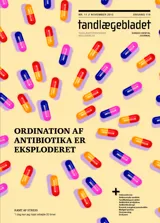Medicinrelateret osteonekrose i kæberne – oversigt og retningslinjer
I artiklen gives en oversigt over osteonekrosernes epidemiologi, symptomer, diagnostik, klinik og behandling. Endelig gives retningslinjer for, hvordan man skal forholde sig vedrørende tandbehandling, oral kirurgi og henvisning af patienter i antiresorptiv behandling.
Osteonekrose i kæberne (Eng. “osteonecrosis of the jaws”, forkortet ONJ) ses i stigende grad verden over. ONJ er en alvorlig komplikation til antiresorptiv behandling med bisfosfonat, denosumab samt visse kemoterapeutika. ONJ kan medføre tab af tænder og kæbedele og invalidere tyggefunktionen. Den antiresorptive behandling anvendes mod knoglemetastaser fra en række maligne tilstande samt mod osteoporose. I den senere tid anvendes antiresorptiv behandling også som adjudant behandling hos postmenopausale kvinder med brystcancer for at reducere risiko for tilbagefald af sygdommen. I artiklen gives en oversigt over osteonekrosernes epidemiologi, symptomer, diagnostik, klinik og behandling. Endelig gives retningslinjer for, hvordan man skal forholde sig vedrørende tandbehandling, oral kirurgi og henvisning af patienter i antiresorptiv behandling.
Osteonecrosis of the jaws (ONJ) is an increasing problem all over the word. ONJ is a severe complication to antiresorptive treatment with bisphosphonate, denosumab, and certain chemotherapeutic drugs. ONJ can lead to loss of teeth and parts of the jaw, and incapacitate the masticatory function. The antiresorptive treatment is used towards metastases from certain malignant conditions and osteoporosis. Lately, the antiresorptive treatment is also used as an adjuvant treatment in postmenopausal women with breast cancer to reduce risk of recurrence. In this paper the epidemiology, symptoms, diagnostic features, clinical findings, and treatment are reviewed. Finally, guidelines are given for dental treatment, oral surgery, and referral of patients on antiresorptive treatment in the primary health care sector.


